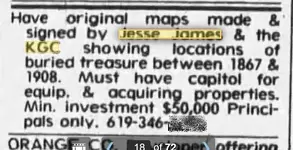I respectfully disagree. The thing about authenticating documents and photographs is that they either Are authentic, or they are NOT. The stories made up around them mean very little unless they relate to actual Provenance, not speculation.
Conspiracy stories claiming documents or photographs as Proof of the conspiracy must meet authentication and provenance standards to be declared Authentic. Simple hearsay that there was a conspiracy behind them in the first place is not considered Provenance. It's merely Hearsay, or at best a theory. Same goes for claims that a document or photograph is a "BS story". Especially when trying to assert that a document is not authentic and was merely a "made up story" in order to bolster a promulgated conspiracy theory. The fact that this document, or letter, WAS AUTHENTICATED by the world's top authority puts the kibosh to that assertion.
Using poor documentation that CAN BE AUTHENTICATED AS SUCH, as a basis for a conspiracy theory, is a very slippery slope. It will eventually come back to haunt the unwary. Before one 'grasps at straws' to validate their theories, they should first make sure the 'straws' have merit. It is easy for our own biases to blind us to the cold hard Facts. Ask John, he knows all about wanting to believe something so badly that you let your instincts be taken over by it.
Early in John's career he made the mistake of unknowingly befriending a very accomplished con-artist. This con was named Lex Cusack.
In the 1990s, John Reznikoff stumbled upon what he thought was the missing link: Official documents finally connecting Marilyn Monroe and President John F. Kennedy, confirming that there was in fact an illicit relationship between them. The documents were the property of Lex Cusack, and were worth millions. They would change history as we knew it. The problem was the documents were forged…fakes, exposed by ABC news.
Here's the story in his own words.
THE KENNEDY-MONROE PAPERS
It was a devastating blow to John, and one that could have destroyed his career. Instead, John's humility in admitting his mistake, taking ownership and using the incident as an impetus to better his methods and those of the industry in order to prevent such happening again, all made him a model for others to follow. Through his efforts he regained the trust of those in the industry and the organizations that use them. Today he is considered the top authority in the world on famous signatures.
There is a lesson here for those willing to learn from his example.













